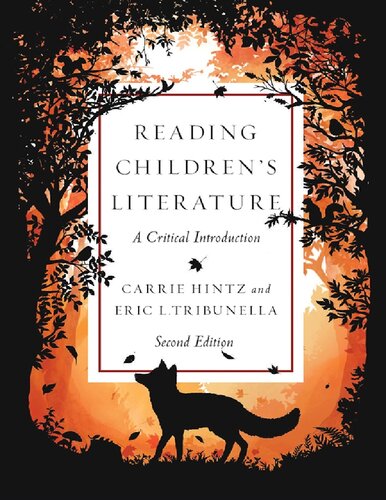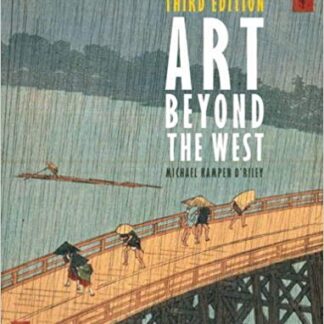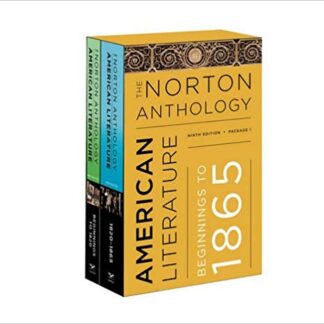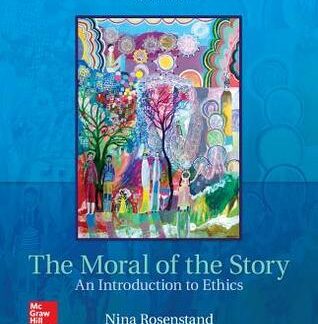Description
Reading Children’s Literature: A Critical Introduction 2nd Edition by Carrie Hintz, ISBN-13: 978-1554814435
[PDF eBook eTextbook]
- Publisher: Broadview Press; 2nd edition (March 28, 2019)
- Language: English
- 624 pages
- ISBN-10: 155481443X
- ISBN-13: 978-1554814435
Reading Children’s Literature offers insights into the major discussions and debates currently animating the field of children’s literature. Informed by recent scholarship and interest in cultural studies and critical theory, it is a compact core text that introduces students to the historical contexts, genres, and issues of children’s literature. A beautifully designed and illustrated supplement to individual literary works assigned, it also provides apparatus that makes it a complete resource for working with children’s literature during and after the course.
Table of Contents:
PREFACE
What Distinguishes this Book?
How this Book Is Organized
What’s New
INTRODUCTION FOR STUDENTS
Common Assumptions about Children’s Literature
What It Means to Read Critically
Reading Closely
Considering Literary History and Forms
Examining Historical and Cultural Contexts
Using Critical and Theoretical Concepts and Approaches
Why Read Children’s Literature Critically?
Dual Address and Complexity
Linguistic and Narrative Complexity
Didacticism and the Lessons of Children’s Literature
The Transmission of Cultural Values
Subversive or Hegemonic?
Pleasure and Unpleasure
CHAPTER 1: HISTORICIZING CHILDHOOD
Historical Models of Childhood
The Romantic Child
The Sinful Child
The Working Child
The Sacred Child
The Child as Radically Other
The Developing Child
The Child as Miniature Adult
Using Models of Childhood to Read Critically
The Uncertain Boundaries of Childhood
Child Crime
Child Sex
Child Soldiers
Child Embodiment and Disability
Child Privilege and Race
Children’s Literature and the History of Childhood
Reading Critically: The History of Childhood
Anne of Green Gables
Explorations
Review
Reect
Investigate
Suggested Readings
Approaches to Teaching Anne of Green Gables
CHAPTER 2: THE EARLY HISTORY OF CHILDREN’S LITERATURE
Questions of Denition
Dening Literature
Dening Children’s Literature
Children’s Literature as Genre
The “Birth” of Children’s Literature?
John Newbery
Newbery’s Contemporaries: Thomas Boreman and Mary Cooper
Sarah Fielding and the First Children’s Novel?
General-Audience and Crossover Works
Aesop’s Fables
Chapbooks
Folk and Fairy Tales
Mixed-Age Works as Children’s Classics
Instructional Works and Didactic Literature
Textbooks
Religious Works
The Sunday School and Evangelical Movements
The Rational Moralists
Didactic Poetry and Fiction
The Golden Age
The Growth of the Children’s Literature Industry
The Crossover Appeal of Golden Age Books
The Tensions that Dene Children’s Literature
The Second Golden Age
Reading Critically: The History of Children’s Literature
Alice’s Adventures in Wonderland
Explorations
Review
Reect
Investigate
Suggested Readings
Approaches to Teaching Alice’s Adventures in Wonderland
CHAPTER 3: POETRY
Nursery Rhymes, Verse, and Poetry
A History of Poetry for Children
Bunyan and Watts
Mother Goose
The Romantic Poets and Nineteenth-Century Children’s Poetry
Forgotten Children’s Poets of the Nineteenth Century
Nineteenth-Century Humorous and Nonsense Poetry
Twentieth- and Twenty-First-Century Poetry
Contemporary Poetry as a Reection on Self and Other
An Expanded Canon
Poetry Picturebooks, Concrete Poetry, and Verse Novels
Children’s Popular Culture and Poetry
Poetry Written by Children
The Separate Tradition of Poetry for Children
Questions to Ask When Approaching a Poem for Children
Common Figures of Speech
Typical Patterned Poetry for Children
Typical Metrical Forms for Poetry in English
Reading Critically: Poetry
“Escape at Bedtime” from A Child’s Garden of Verses
Explorations
Review
Reect
Investigate
Suggested Readings
Approaches to Teaching “Escape at Bedtime”
CHAPTER 4: FAIRY TALES
Denition of the Fairy Tale
Fairy Tales and Revision
Fairy Tales Worldwide
Fairy Tales and Ancient Myth
A History of the Literary Fairy Tale in the Western World
The Early Modern Roots of the Literary Fairy Tale
Fairy Tales in the Nineteenth Century
Oral Tales versus Literary Fairy Tales
Fairy Tales: Mass Media and Film
The Social Function of Fairy Tales
Fairy Tales and Unhappy Endings
Interpreting Fairy Tales
Psychoanalytical Approaches
Sociohistorical Approaches
Feminist Responses to Fairy Tales
Fairy-Tale Revision as Critical Practice
Queer Fairy Tales
Fairy Tales and Disability
Race in Disney’s Fairy Tale Films and Television
Race in Fairy Tales and Folk Tales
Reading Critically: Fairy Tales
Trina Schart Hyman’s Retelling of “Little Red Riding Hood”
Explorations
Review
Reect
Investigate
Suggested Readings
Approaches to Teaching “Little Red Riding Hood”
CHAPTER 5: PICTUREBOOKS, GRAPHIC NOVELS, AND DIGITAL TEXTS
Dening the Picturebook
A History of Picturebooks
Precursors to Picturebooks
The Picturebook as a Commercial Form
Twentieth-Century Picturebooks
How Words and Images Relate
Wordless Picturebooks
The Relationship of Authors and Illustrators
Artistic Choices in the Production of Picturebooks
The Size of the Book
The Size of the Picture against the Page
The Composition of Objects on the Page
The Use, Amount, and Quality of Color
The Strength of Line
The Medium Used
Some Media Used in the Production of Picturebooks
Mixed Media
Setting
Text within the Pictures
Concerns about Picturebooks
Availability and Cost of Picturebooks
New Frontiers for Visual Texts
Reinventing the Concept Book
Graphic Novels
A Brief History of the Graphic Novel
Graphic Narratives and the Child and YA Reader
Reading Graphic Novels Critically
Terms for the Analysis of Graphic Novels
Digital Media for Children
Forking Path Storylines
Print and Online Combinations and Relationships
Reading Critically: Picturebooks
There Is a Bird on Your Head!
Explorations
Review
Reect
Investigate
Suggested Readings
Approaches to Teaching There Is a Bird on Your Head!
CHAPTER 6: DOMESTICITY AND ADVENTURE
Dening Domesticity and Adventure
Domestic Fiction for Children
Realism and Everyday Life
The Home as a Dangerous Place
Illness and Disease
Power Relations
Social Class
Psychological Complexity
Adventure Fiction for Children
Power Relations and Superheroics
Escaping Civilization or Home
Colonialism and Imperialism
Hybridity: Domestic Adventures and Adventurous Domesticity
Questions of Audience: Boy and Girl Readers of Domestic Fiction
and Adventure
Contemporary Domestic and Adventure Stories
Contemporary Examples
Reimagining Adventure and Domestic Fiction
Adventure and Domesticity in Picturebooks
Reading Critically: Domesticity and Adventure
Holes
Explorations
Review
Reect
Investigate
Suggested Readings
Approaches to Teaching Holes
CHAPTER 7: HISTORICAL FICTION
Dening the Historical Novel
Common Moments or Events in Historical Fiction for Children
The Use of Historical Settings in Children’s Literature
Trauma and Historical Children’s Fiction
Nostalgia and Nationalism
Popular Culture and Series Books
Awards for Historical Children’s Literature
Fiction versus History
Rethinking the Writing of History
The Strengths of Historical Fiction
Problems with Representing the Past
Accuracy
Authenticity
Presentism
Artistic Freedom and Historical Responsibility
Controversy and Historical Fiction
The Use of Afterwords, Authors’ Notes, and Epilogues
Time-Travel and Time-Slip Narratives
Reading Critically: Historical Fiction
Johnny Tremain and My Brother Sam Is Dead
Explorations
Review
Reect
Investigate
Suggested Readings
Approaches to Teaching Johnny Tremain
CHAPTER 8: NONFICTION—HISTORY, SCIENCE, LIFE WRITING
Nonction and Informational Books: Some Distinctions
Conduct Literature
Nineteenth-Century Conduct Books
Reinventing the Boy’s Own Book and Girl’s Own Book Tradition
Contemporary Health and Sexual Education Books
Life Writing: Biography, Autobiography, Memoir, Diaries
Life Writing for Children
Autobiographies, Memoirs, and Diaries
Picturebook and Graphic Autobiographies, Biographies, and
Memoirs
History Writing
Exploring the Past in Nonction
Innovative Approaches to Historical Nonction
Science and Discovery
Early Science Books: A Sense of Wonder
Contemporary Science Books
Experimentation in Science Writing for Children
Critical Issues in Nonction
Fictional Stories in Nonction
Simplication and Complexity
Accuracy and New Research
Reading Critically: Nonction
We Are the Ship: The Story of Negro League Baseball
Explorations
Review
Reect
Investigate
Suggested Readings
Approaches to Teaching We Are the Ship
Some Fiction–Nonction Pairs and Groups
Historical Fiction and Nonction
World War II Books
Science, the Natural World, and Technology Books
Additional Resources
CHAPTER 9: FANTASY AND REALISM
Genre
Genre as a Guide for Readers
Fantasy
Early Roots of Fantasy
Nineteenth- and Early Twentieth-Century Fantasy
Postwar Twentieth-Century Fantasy
Recent Children’s and YA Fantasy
Types of the Fantastic
Anthropomorphic Fantasy
Secondary Worlds and High Fantasy
Fantasy that Inhabits Our World
Experiencing the Fantastic
Fantasy as a Reversal of Expectations
Fantasy Literature and Responsibility
The Fantastic and the Natural World
Realism
Dening Realism and the “New Realism”
Early New Realism and the Problem Novel
Contemporary New Realism
Diversity in New Realist Fiction
New Realism and Series Books
New Realism and Trauma
Fantasy and Realism in Picturebooks
Authors Working in Both Fantasy and Realism
Literary Genres as a Response to Children’s Needs
Fantasy Elements in Realistic Texts, Realistic Elements in Fantasy
Texts
Magical Realism
Reading Critically: Fantasy and Realism
Shadowshaper
Explorations
Review
Reect
Investigate
Suggested Readings
Approaches to Teaching Shadowshaper
CHAPTER 10: RACE, ETHNICITY, AND CULTURE
The History of Race, Ethnicity, and Culture in Children’s
Literature
The Early History of Racial Representation in Children’s
Literature
African American Children’s Literature
Jewish Children’s Literature
Latinx Children’s Literature
Asian American Children’s Literature
Native Americans and First Nations in Children’s Literature
A Word about Ethnicity and Culture
The Need for Diverse Books
Awards
Key Terms and Controversies
Authorship and Ownership
Audience
Perspective
Reclamation
Authenticity and Accuracy
Artistic Freedom and Ethical Responsibility
Reading Critically: Race in Children’s Literature
The Snowy Day
Explorations
Review
Reect
Investigate
Suggested Readings
Approaches to Teaching The Snowy Day
CHAPTER 11: GENDERS AND SEXUALITIES
The Signicance of Gender and Sexuality in Children’s Culture
Gender and Sexuality in Childhood
Toys, Clothes, and Bathrooms
Disney
Gender and Sexuality in Children’s Literature
Dening Sex/Gender
Sex and Gender
Gender as Performance
Gender as Identity
Gender and Class
Childhood Gender
Boys and Girls
Tomboys and Sissies
Boys and Boyhood in Children’s Literature
The Boys’ School Story
Boys’ Adventure Fiction
The Bad-Boy Book
The Feral Tale
The Unconventional Boy in Children’s Literature
Boys and Popular Literature
Girls and Girlhood in Children’s Literature
The Girls’ School Story
Domestic and Family Stories
Girls’ Adventure Fiction
Orphans and Good Girls
Realist Fiction and Problem Novels for and about Girls
Girls’ Contemporary Series Fiction
The Diverse Girlhoods of Children’s Literature
Sexuality in Children’s Literature
Dening Sexuality
The Sexuality of Children
Queering the Classics of Children’s Literature
LGBT Representation in Picturebooks and Fiction for Younger
Readers
LGBT Representation in Young Adult Literature
Awards for LGBT Children’s and Young Adult Literature
Reading Critically: Gender and Sexuality in Children’s Literature
A Little Princess
Explorations
Review
Reect
Investigate
Suggested Readings
Approaches to Teaching A Little Princess
CHAPTER 12: CENSORSHIP AND SELECTION
Censorship: Denitions and Key Terms
Censorship
Challenges
Selection
Prizing and Censorship
The First Amendment and Freedom of Speech
Children’s Vulnerability versus Children’s Resilience
Key Moments in the Censorship of Children’s Literature
Specic Reasons for Censorship
Self-Censorship/Subtle Censorship
Individuals versus Groups
Selection and a Parent’s Rights
Critical Reading as Anti-Censorship Activity
Reading Critically: Censorship and Selection
The Harry Potter Series
Explorations
Review
Reect
Investigate
Suggested Readings
Approaches to Teaching Harry Potter and the Sorcerer’s Stone
CHAPTER 13: CHILDREN’S LITERATURE AND POPULAR CULTURE
Popular Culture
Dening Popular Culture
Popular Culture, Ideology, and the Culture Industry
Popular Genres and Genre Fiction
Science Fiction
Utopian and Dystopian Fiction
Detective and Mystery Fiction
Horror Fiction
Romance Fiction
Formula Fiction
Adaptations of Children’s Literature as Popular Culture
Children’s Literature as Inspiration
Stage Adaptations
Film Adaptations
Race in Children’s Adaptations
Children’s Television Adaptations
Theorizing Adaptation and Transformation
Dening Adaptation
Transformation and Intertextuality
Fanction: The Pleasures and Possibilities of Adaptation and
Subversive Repetition
Analyzing Children’s Film
The Gaze
The Semiotics of Film
Common Terms for Film Analysis
Reading Critically: Children’s Literature and Popular Culture
The Fault in Our Stars
Explorations
Review
Reect
Investigate
Suggested Readings and Viewings
Approaches to Teaching The Fault in Our Stars
GLOSSARY
WORKS CITED
CHILDREN’S BOOK AWARDS
The Caldecott Medal (since 1970)
The Newbery Medal (since 1970)
Phoenix Award
Phoenix Picture Book Award
ACKNOWLEDGMENTS
PERMISSIONS ACKNOWLEDGMENTS
Carrie Hintz is Associate Professor of English and teaches children’s and young adult literature at Queens College of the City of New York and the Graduate Center at CUNY. Eric L. Tribunella is Professor of English at the University of Southern Mississippi.
What makes us different?
• Instant Download
• Always Competitive Pricing
• 100% Privacy
• FREE Sample Available
• 24-7 LIVE Customer Support







